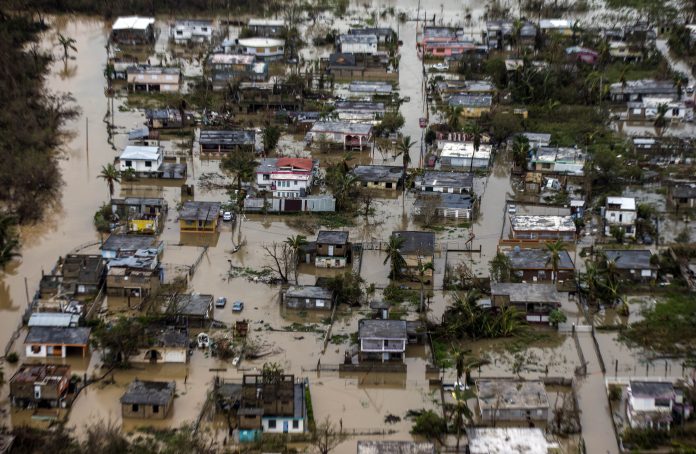
Tens of thousands of residents in northwestern Puerto Rico were ordered to evacuate Friday amid fears that a dam holding back a large inland lake was in imminent danger of failing because of damage from Hurricane Maria’s floodwaters.
Officials worried that as many as 70,000 people could be in the path of a massive amount of rushing water in the event the Guajataca Dam releases into the Guajataca River, which flows north through low-lying coastal communities and empties into the ocean.
The dam suffered a “fissure,” Puerto Rico Gov. Ricardo Rosselló said in a news conference Friday afternoon. Residents in the municipalities of Quebradillas, Isabela and part of San Sebastian could be affected if the dam collapses, he said, and it could be a catastrophic event.
“To those citizens . . . who are listening: Please evacuate,” Rosselló said as buses were dispatched to ferry residents out of harm’s way. “We want your life to be protected. . . . Please, if you’re listening, the time to evacuate is now.”
Abner Gomez, executive director of Puerto Rico’s emergency management agency, said in an interview late Friday that the dam’s gates suffered mechanical damage during the storm, making it impossible for them to open and let out normal water currents. Officials worry that could cause the dam to spill over.
Gomez said that under current conditions, with water rising after the hurricane, “there is no way to fix it” right now. Additional water flowing into the lake could create sudden dangers, so emergency evacuation was the only option, he said. If the dam spills over or fails structurally, he said, “thousands of people could die.”
The urgent situation Friday came more than 48 hours after Hurricane Maria slammed into Puerto Rico’s southeastern coast as the most powerful storm to strike the island in more than 80 years. It was a reminder that Maria’s impact on Puerto Rico is far from over; officials still have little sense of the scope of the damage as a communications and power blackout continued to affect nearly everyone in the U.S. territory.
Gomez characterized Maria as “one of the greatest natural disasters” in recent U.S. history, comparing it to Hurricanes Katrina and Sandy. The destruction in some parts of the island “looked more like a tornado than a hurricane,” he said. Rescue and recovery could take months, he said, and a “return to normalcy” could take at least a year.
Authorities on Friday reported six deaths across the island. Three of the fatalities occurred in the municipality of Utuado as a result of mudslides, Puerto Rico’s public safety department said in a statement. Two others died in flooding in Toa Baja, and one other person died in Bayamón when a panel struck him in the head. More deaths are likely to be reported in coming days as search-and-rescue crews reach previously inaccessible areas, officials said.
“We are aware of other reports of fatalities that have transpired by unofficial means, but we cannot confirm them,” said Héctor Pesquera, secretary of the public safety department.
Though damage assessments have been nearly impossible, early reports reveal an island ravaged by Maria’s high winds and torrential rains, with roofs peeled open like tin cans, neighborhoods waterlogged, and trees that were lush just days ago now completely stripped bare of leaves. The hurricane plowed through the entire 100-mile island, with the eye tracking diagonally from the southeast to the northwest.
“Every vulnerable house here made out of wood was completely or partially destroyed during the path of the eye of the hurricane,” Rosselló said of an island where many homes are constructed with wood foundations and zinc roofs. “Puerto Rico has endured an horrific ordeal.”
The lack of communications has isolated rural areas of the island. Just 15 percent of Puerto Rico’s communication towers are working, and some transmission towers have collapsed. Up to 85 percent of the island’s fiber cables are damaged.
Power remains completely out across the island, and just 25 percent of it has water service.
Shock has given way to frayed nerves as officials warned that it could be months before power is restored to some areas, and there is no indication of when communications infrastructure will be fixed. In San Juan, the capital, streets were choked with traffic as people tried to find loved ones and spent hours waiting in line for gas.
Puerto Rico, with 3.5 million U.S. citizens, also is facing a crisis due to geography: It is an island dependent on air and sea for supplies and help. The immediate response that occurred after Hurricane Harvey in Houston, where volunteers from Louisiana headed in during the storm, or after Hurricane Irma in Florida, where utility trucks were pre-positioned to assist, is impossible here.
(c) 2017, The Washington Post · Samantha Schmidt, Katie Zezima, Sandhya Somashekhar, Daniel Cassady
{Matzav.com}










